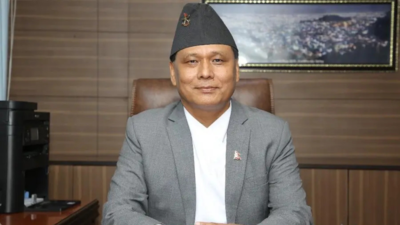ARTICLE AD BOX

Nepal is witnessing the aftermath of a dramatic political upheaval triggered by a Gen Z-led mass protest movement that recently forced the resignation of prime minister KP Sharma Oli.
The protests began primarily as a reaction to Oli's government's ban on several social media platforms but quickly evolved into a broader anti-corruption and political reform uprising. When the protests prompted Oli to resign, the country’s ceremonial president Ram Chandra Poudel asked him to lead a transitional government until a new one could be put in place. But Oli fled from his official residence, and his whereabouts were not clear.Here are 10 key points to understand the current situation and Kulman Ghising's emerging role as a front-runner to lead Nepal's next government.
Gen Z protest, government overthrow
- The protests were led mainly by Nepali youth aged 13 to 28, collectively known as Generation Z, mobilising through social media channels such as TikTok, Instagram, and Telegram.
- Demonstrators opposed what they considered systemic corruption, restrictions on freedoms, and the elite's lavish lifestyles epitomised by "Nepo Kids" — children of established politicians flaunting wealth openly.
- The demonstrations escalated violently over days, leading to clashes with security forces, destruction of government property including Parliament, and the loss of at least 29 lives.
- Despite calls from many original activists to maintain peaceful protests, opportunistic elements infiltrated and intensified violence and chaos during the unrest.
Oli's resignation
- Amid mounting pressure and escalating violence, PM Oli resigned on September 9, citing the extraordinary situation in the country and the need to facilitate a political resolution.
- Oli's resignation was followed by nationwide curfews enforced by the Nepal army, which took control of security to restore order.
- The resignation has created a political vacuum and initiated a search for an interim government to steer Nepal until fresh elections.
Sushila Karki & Balen Shah
- Former Chief Justice Sushila Karki, known for her firm anti-corruption stance, was reportedly chosen by the Gen Z movement initially to lead an interim government.
- Karki, who has expressed admiration for Prime Minister Narendra Modi and pledged to strengthen Nepal-India relations, accepted the Gen Z mandate to serve in this role.
- However, her role as leader faced challenges from other contenders and evolving political dynamics.
- Kathmandu mayor Balen Shah was also touted as a possible contender. He backed Karki for the role
Kulman Ghising: The new front-runner
- 54-year-old Kulman Ghising, former managing director of the Nepal Electricity Authority, has emerged as the strongest candidate for Nepal’s interim Prime Minister.
- Ghising is widely respected for his successful work in ending Nepal’s longstanding nationwide electricity load-shedding crisis, earning him a reputation as a clean and capable technocratic leader.
- Unlike traditional politicians, Ghising is seen as apolitical and pragmatic, which resonates with the Gen Z protesters' demand for a government free from corruption and political nepotism.
- After Sushila Karki and Kathmandu Mayor Balendra Shah stepped aside, the Gen Z movement formally backed Ghising to lead the interim council.
- Kulman Ghising was born on November 25, 1970, in Bethan village, Ramechhap District, Nepal, and comes from a humble rural background, which shaped his grounded and persevering nature.
- He holds a Bachelor's degree in Electrical Engineering from the Regional Institute of Technology in Jamshedpur, India, a Master's in Power Systems from Pulchowk Engineering College, Kathmandu, and an MBA from Pokhara University, equipping him with strong technical and managerial expertise.
- Ghising joined the Nepal Electricity Authority (NEA) in 1994 as an electrical engineer and held various technical and administrative positions over two decades, including project chief of the Rahughat Hydroelectricity Project and managing director of the Chilime Hydropower Company.
- Appointed Managing Director of NEA in September 2016, he took charge when Nepal was enduring up to 18 hours of daily load-shedding (power cuts), which affected the economy and quality of life nationwide.
- Under his tenure, NEA became profitable for the first time, and Nepal effectively ended load-shedding in urban areas by early 2017, a monumental achievement that restored electricity 24/7 to major cities and significantly reduced outages nationwide.
What lies ahead
- The Nepal army remains key in maintaining peace and overseeing the transition.
- Gen Z protesters continue to demand immediate political reforms including new constitutional provisions to prevent political entrenchment and corruption.
- The interim government led by Ghising, if appointed, will be tasked with guiding Nepal through this turbulent transition to new elections and democratic renewal.
What Nepal citizens are saying
- "I feel there should be an election soonest and new leaders who are able to work for the country should be elected,” said Sanu Bohara, a shop owner. “After all this what we need is peace. I feel there should not have been so much destruction, but that has already happed.”
- Anup Keshar Thapa, a retired government officer who was looking at the charred official residences of ministers, said it was not clear who would lead the country and if people would actually listen to them. “If the protests had gone in an organized way, it would be clear who was leading," he said.



.png)
.png)
.png)
















 2 hours ago
3
2 hours ago
3







 English (US) ·
English (US) ·